ABSTRACT
The use of grass strips in agricultural landscapes is widely recognized for their ability to effectively reduce surface runoff and the transport of eroded particles, while simultaneously enhancing biodiversity and landscape stability. This study aimed to quantify the impact of grass strip length on sediment retention in surface runoff. Experimental measurements were conducted on enclosed plots measuring 8 × 1 metres, each with varying proportions of grass cover to simulate different grass strip widths under real-world conditions. Four treatment variants were tested: variant 1 with 0% grass cover (8 m bare soil); variant 2 with 25% grass cover (6 m bare soil and 2 m grass); variant 3 with 50% grass cover (4 m bare soil and 4 m grass); and variant 4 with 100% grass cover (8 m grass). Each variant was tested in triplicate. To simulate surface runoff with a high sediment load, an artificial suspension composed of water and finely ground sand with an average particle size of 27 μm and a target concentration of 40 g · l-1 was applied to the plots via a distribution system at a flow rate of 1 l · s-1 for 20 minutes from the onset of runoff. Results indicated that relative runoff volume decreased progressively with increasing grass cover, from 100% in the bare soil variant to 91%, 76%, and 71% in the 25%, 50%, and 100% grass cover treatments, respectively. Sediment transport was reduced even more substantially, from 100% in bare soil conditions to 51%, 24%, and 15% with increasing grass cover. Additionally, the velocity of surface runoff within the grass-covered areas was approximately 6.4 times lower than in bare soil conditions. The mean grain size of transported sediment decreased from 36 μm in the bare soil variant to 6.6 μm in the 100% grass cover treatment. These findings demonstrate that, under the given experimental conditions, increasing the proportion of grass cover significantly reduces both surface runoff and sediment transport. Moreover, vegetation plays a crucial role in promoting selective deposition of coarser sediment particles due to the substantial reduction in runoff velocity within the vegetated area.
INTRODUCTION
Grass strips in agricultural landscapes are generally considered an effective method for reducing surface runoff and preventing the transport of eroded particles further downslope [1] (Fig. 1). For this reason, they are commonly used either as a standalone agrotechnical measure or as part of a broader system of buffer strips within the standards of Good Agricultural and Environmental Conditions (GAEC) and the EU Common Agricultural Policy (CAP).
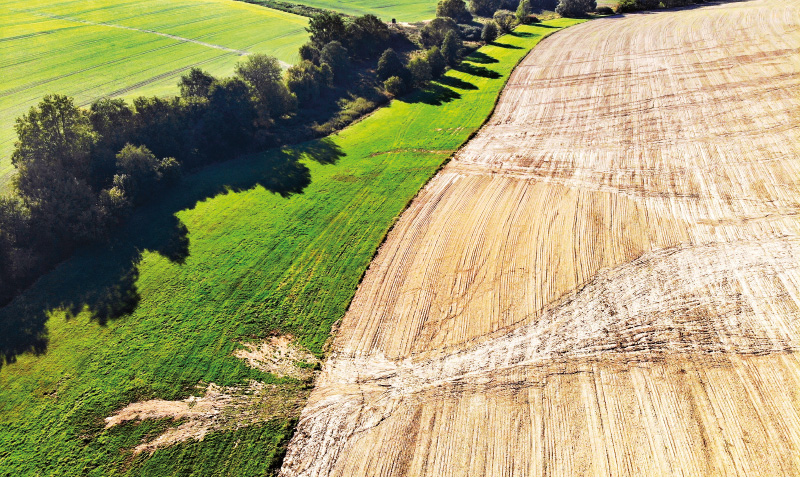
Fig. 1. Example of an erosion event at the boundary between a grass strip and arable land (photo: T. Laburda)
The benefits of grass strips lie not only in soil protection, but also in their positive impact on the quality of aquatic ecosystems and landscape stability [2–4]. By providing a suitable habitat for various plant and animal species, they support biodiversity and become a key element of sustainable landscape management [5]. Moreover, plants with deep root systems help stabilise soil structure and increase its resistance to erosion [6]. The effectiveness of these measures lies not only in slowing down runoff and increasing water infiltration [7, 8], but also in the sediment retention effect that occurs before water enters the grass strip, which gradually leads to the formation of terraces and a reduction in the longitudinal slope of the hillside, thereby slowing further erosion [9]. Various experimental methods are used to assess the effectiveness of grass strips, including the use of natural rainfall [10, 11], rainfall simulation using rainfall simulators [12], and direct simulation of surface runoff [13, 14]. Some studies even combine the use of rainfall simulators with the release of surface runoff to create the most realistic conditions possible using multiple methods, in order to analyse the effects of vegetation on erosion and sedimentation as accurately as possible under real-world conditions [12, 15]. In addition to several-metre-wide grass strips, there are also narrow grass barriers; the sturdy stems of selected plant species with lower spatial requirements effectively trap sediment and may even be more efficient in conditions of concentrated surface runoff [16, 17].
The presented study focuses on assessing the effectiveness of grass strips in reducing soil erosion, runoff, and sediment transport under controlled conditions. Its contribution primarily lies in verifying the methodological approach for the most realistic quantification of the effects of grass strips. The main objectives of the study are (1) developing and testing a system simulating surface runoff and sediment transport on agricultural land, and (2) applying the tested methodology to assess the impact of different lengths of grass cover (or grass strip width) on the ability to retain surface runoff and sediment. However, the set objectives represent only a partial step towards assessing the applicability of this measurement in more extensive research, which should follow from this pilot activity.
METHODOLOGY
The experimental measurements were carried out at Řisuty in the Czech Republic, located in Central Bohemia, approximately 30 km northwest of Prague (50.2173N, 14.0169E), at an altitude of 310–315 m above sea level. The area has a humid continental climate with an average annual temperature of 8°C and an average annual precipitation of 500 mm. The topsoil layer contains 9% clay, 55% silt, and 36% sand, which, according to the USDA-NCRS classification system, corresponds to silty loam. The dominant grass species was timothy (Phleum pratense), with meadow fescue (Festuca pratensis) and perennial ryegrass (Lolium perenne) present in smaller amounts.
The experimental plots measured 8 × 1 m and were created in four variants (Fig. 2) according to the grass cover ratio: 0% (variant 1), 25% (variant 2), 50% (variant 3), and 100% (variant 4). In real-world conditions, these variants would correspond to a field with bare soil without a grass strip (variant 1), or fields with grass strips of 2, 4, and 8 m in width (variants 2–4). Each variant was created and tested in three replications to ensure statistical relevance.
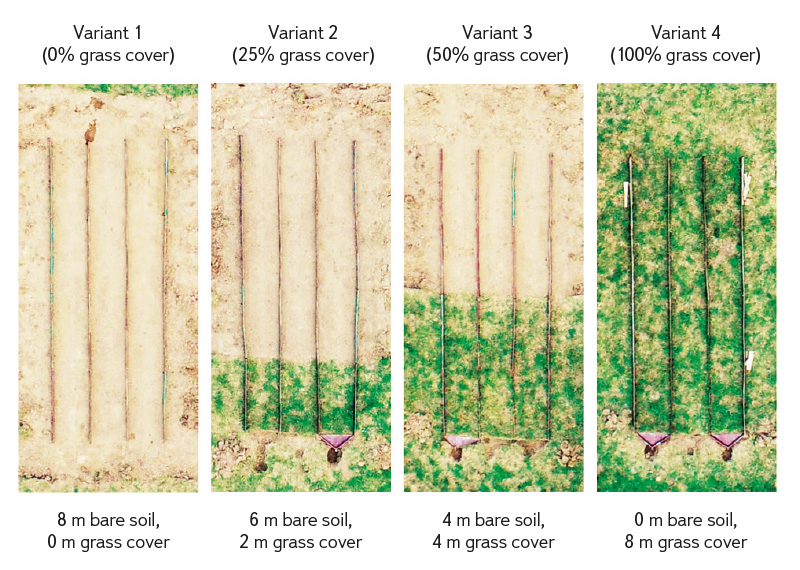
Fig. 2. Orthophoto images of the experimental plots for tested variants 1–4
The experimental measurements involved the release of a prepared suspension of solid particles simulating eroded sediment and water into the experimental enclosed area, followed by the retention of surface runoff at the discharge point. The target concentration of the suspension was 40 g · l-1, and the material used was finely ground sand with a median grain size of 27 μm. The inflow at the upper edge of the plot was set to 1 l · s-1. These values were selected based on steady-state runoff rates observed during previous repeated measurements using a rainfall simulator at the same site. They therefore represent realistic values that may occur during actual erosion events. Finely ground sand was chosen as a well-defined granular material whose grain size and bulk density closely corresponded to the values of eroded material observed during real erosion experiments using a rainfall simulator on actual field plots. The suspension was prepared in a 500-litre tank, into which water was continuously supplied in order to maintain a constant water level (to ensure steady gravitational discharge of flow onto the plot). The specified sediment was added to the tank at short intervals and kept in suspension by a sludge pump operating continuously within the tank. The suspension homogeneity was monitored through repeated sampling from the tank and at the inflow to the experimental plots.
Each experiment lasted 20 minutes from the onset of surface runoff at the closing profile. Surface runoff was measured at one-minute intervals during the first ten minutes, and at two-minute intervals during the following ten minutes. The sampling time was always recorded to determine the flow rate over time. Further analysis of the collected samples was carried out in the laboratory, where the samples were filtered, dried, and the amount (weight) of sediment was determined.
A selected number of samples (three samples from each measurement, taken at the 4th, 9th, and 20th minute of surface runoff) was further analysed using a Mastersizer 3000 laser diffractometer (Malvern Panalytical) to determine particle size distribution.
Surface runoff velocity was measured on each variant and replication three times in succession after the 15th minute of the experiment. Measurement was carried out using a coloured solution (Brilliant Blue), which was applied at the beginning of a continuous section of bare arable soil and grass cover, while the time taken to reach the end of this section was recorded.
The experimental measurements were conducted based on previous experiences gained within the international project LTAUSA19019, during which a device for discharging a suspension, replacing surface runoff, was tested at several other sites under identical conditions.
RESULTS
Based on the monitoring measurements, actual average flow rate and concentration of suspension at the inflow to the experimental areas were calculated. Average inflow to the area reached a value of 1.02 ± 0.13 l · s-1, and the average concentration of the created suspension was 33.5 ± 3.7 g · l-1.
Surface runoff
The graph in Fig. 3 shows average runoff values from individual replicates of the plots for variants 1–4 from the onset of surface runoff. The fastest increase in runoff was observed in variant 1, which lacked grass cover. In the other variants, runoff increase was slower, depending on the proportion of grass cover. After 20 minutes of surface runoff, variant 2 reached an almost identical runoff rate of approximately 0.95 l · s-1 as that of variant 1 without grass cover. In contrast, variants 3 and 4 also reached very similar values of approximately 0.85 l · s-1 at the end of the experiment.
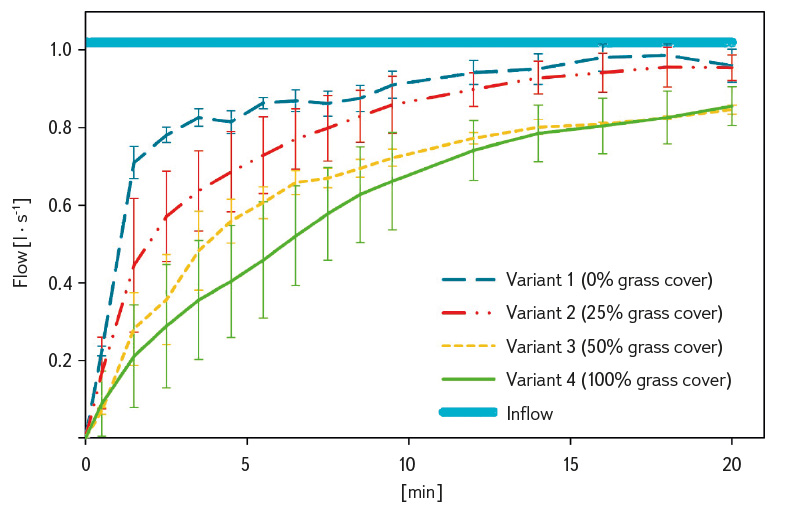
Fig. 3. Surface runoff progression for tested variants 1–4. The values shown are the averages of three replicates for each variant; error bars represent the standard deviation of the individual replicates
Average surface runoff velocity values for each plot variant are presented in Tab. 1. Total average surface runoff velocity on bare soil reached 0.58 ± 0.04 m · s-1, with very little deviation between the individual variants. On the grass-covered section, average surface runoff velocity was 0.09 ± 0.01 m · s-1. On average, runoff velocity on the grass-covered plot decreased approximately 6.4 times compared to the plot without vegetation cover.
Tab. 1. Average surface runoff velocities of variants 1–4

Sediment
The graph in Fig. 4 shows average runoff concentration values from the plots of variants 1–4 from the onset of surface runoff. Variant 1, without grass cover, reaches very high values – up to 160 g · l-1 – within the first two minutes of runoff, followed by a rapid decline to a steady value of approximately 33 g · l-1. This development indicates very high erosion of unprotected soil at the beginning, followed by an almost complete inability to retain additional sediment from the discharged suspension. In contrast, variant 2 shows that initial erosion from bare soil is significantly reduced thanks to – even minimal – grass cover. In the first two minutes of runoff, the concentration reaches a maximum value of only 19 g · l-1. This is followed by a rapid decline and then only a slight increase as the capacity of the grass cover to retain sediment particles from the discharged suspension becomes gradually exhausted. At the end of the experiment, a concentration of approximately 27 g · l-1 is achieved. Variant 3 also shows a local increase in concentration at the beginning due to erosion of bare soil, but the subsequent rise is very gradual, and by the end of the experiment, it reaches a value of approximately 13 g · l-1. In variant 4, no local increase in concentration is observed at the beginning of runoff due to the absence of a bare, unprotected soil area. Nevertheless, even in this variant, there is a very slow increase in runoff concentration, reaching a value of approximately 9 g · l-1 by the end of the experiment.
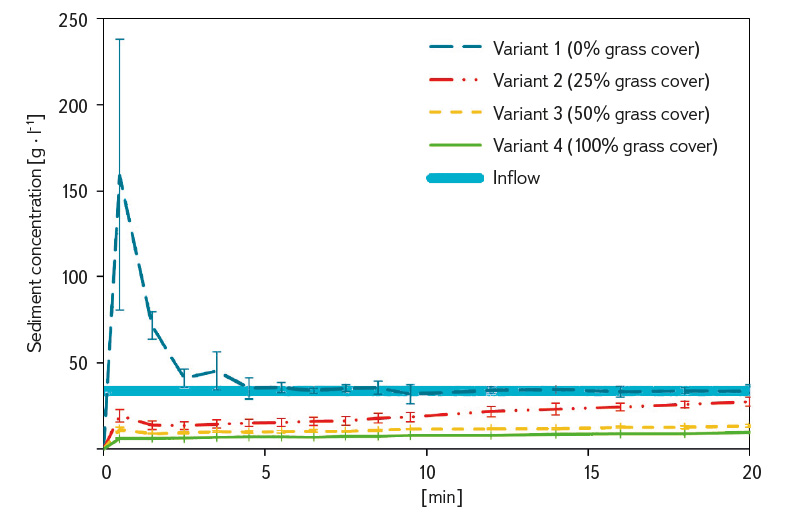
Fig. 4. Surface runoff concentration progression for tested variants 1–4. These values represent the averages of three replicates for each variant, with error bars indicating the standard deviation of the individual replicates
Sediment retention efficiency and runoff reduction
Based on the measured values throughout the experiments, cumulative values of runoff and sediment quantities for each variant were calculated, as shown in Fig. 5. As expected, sediment concentration in the runoff from the plots of variant 1, without grass cover, was the highest and therefore it was considered as 100%. Reductions in the other variants were then calculated relative to the values of variant 1.
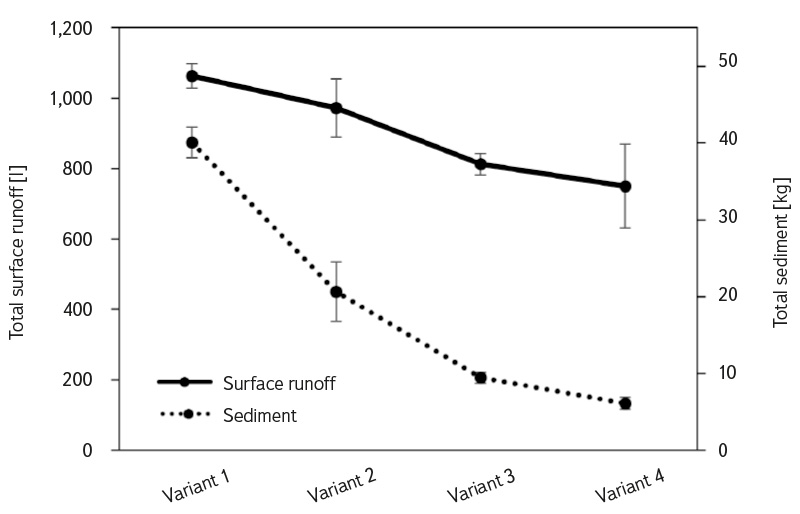
Fig. 5. Total amount of surface runoff and sediment for variants 1–4. These values represent the averages of three replicates for each variant, with error bars indicating the standard deviation of the individual replicates
The above graph shows that with a higher proportion of grass cover, both the total amount of runoff and erosion decrease. Runoff was reduced by 9% in variant 2 (25% grass cover), in variant 3 (50% grass cover) by 24%, and in variant 4 (100% grass cover) surface runoff decreased by 29%. In total, runoff decreased from 1,063 l to 972 l, and from 812 l to 750 l. The amount of sediment decreased even more significantly due to the effect of grass cover. In variant 2 (25% grass cover), the amount of sediment decreased by 49%, in variant 3 (50% grass cover) by 76%, and in variant 4 (100% grass cover) sediment decreased by 85%. In total, sediment quantity reduced from the original 40 kg to 21 kg, and from 9 kg to 6 kg.
Grain size distribution
The graph in Fig. 6 shows the representation of individual particle size fractions in the outflow for variants 1–4, along with the mean grain size d50. By converting the overall grain size distribution of the sediment into the categories of clay (particles smaller than 2 μm), silt (particles from 2 μm to 50 μm), and sand (particles from 50 μm to 2 mm), the effect of grass strips in terms of selective sedimentation is illustrated. Most nutrients that negatively affect watercourses and reservoirs, such as phosphorus, nitrogen, and potassium, are mobilised primarily with clay particles, i.e. the finest fraction. A comparison of individual variants shows that the proportion of sand fraction decreases significantly in variant 2 and is almost negligible in variants 3 and 4. This marked decrease can also be observed in the silt fraction in variant 2; however, the subsequent reduction is no longer as pronounced. In the case of the clay fraction, there is an average decrease of 1 g (33%) between variant 1 and variant 2, but the change in the following variants is negligible.
This aspect is also reflected in the d50 value. In variant 1, a value of 36 μm was recorded at the outflow from the area due to the high erosion of unprotected soil. In variant 2, the filtering effect of transported material by the grass cover had already begun to take effect, resulting in a gradual reduction in the mean grain size – to 17.9 μm in variant 2, 8.3 μm in variant 3, and 6.6 μm in variant 4. The above findings show that grass strips effectively slow down the movement of coarse particles; however, they have a significantly smaller impact on the mobility of clay particles, which pose the greatest risk in terms of qualitative pollution. It should be reiterated that these are preliminary results aimed at verifying the experimental methodology. The retention ratio will strongly depend on the width of the strip and the duration of the runoff event, as well as on the volume of water discharged.
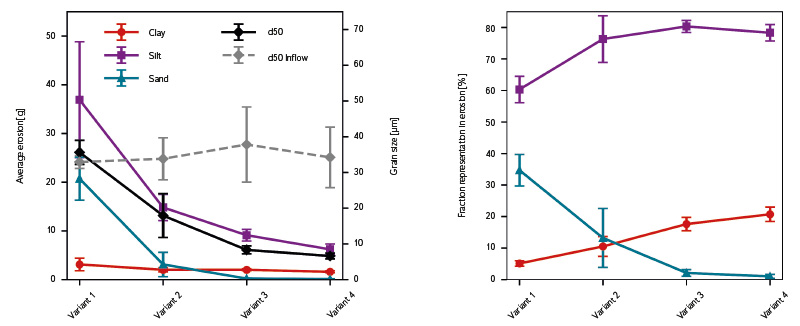
Fig. 6. Average soil erosion (g) and particle size distribution (%) of clay, silt, and sand for variants 1–4, including median grain size d50 of both the transported material and the inlet (prepared suspension); error bars represent the sample standard deviation
DISCUSSION
The results show that grass strips can be a highly effective measure for reducing surface runoff and sediment transport. However, the overall effectiveness heavily depends on the grass strip width and varies for runoff and sediment reduction. For example, the values for the fully grassed variant 4 reached only 71% of total surface runoff and 15% of total sediment quantity compared to the overall values of variant 1. The results clearly demonstrated that with an increasing proportion of vegetation, both runoff and sediment are reduced more, which is consistent with the findings of other studies [4, 18]. Although the presented study did not test more slope variants, other studies [19, 20] suggest that the primary factor influencing the effectiveness of runoff and erosion reduction is the length of the grass strip, rather than the slope on which the strip is located.
Based on the analysis of the grain size distribution, a decrease in the mean grain size of the eroded material was observed with an increasing proportion of vegetation, indicating the ability of grass strips to effectively capture only certain particle fractions. This effect has also been confirmed in other studies [4, 8, 10]. The effect of selective sedimentation in the area of vegetation cover is crucial with regard to nutrient transport, which is primarily associated with the transport of clay particles (< 2 μm). In this regard, it can be said that, under the tested conditions with this species composition and vegetation density, grass strips represent only a minimal obstacle to the transport of clay particles.
CONCLUSION
The above experiments were conducted based on the requirement to determine easily comparable parameters for different variants of grass strip lengths. Their results raise a number of questions related to the impact of flow rates, slope, vegetation density and species composition, duration of runoff, and the grass strip width. However, this pilot study with a limited number of experiments demonstrated that even relatively narrow grass strips can significantly reduce surface runoff and sediment quantity. With complete grass cover, a reduction of up to 29% in runoff and 85% in sediment was achieved, highlighting the potential of these measures in protecting agricultural land from erosion and water resources from sedimentation. The expected effect on reducing nutrient transport is lower, as grass strips primarily retain larger particles, which alters the enrichment ratio. Nevertheless, grass strips can be an effective solution both for agricultural production and for protecting water quality. The presented pilot study, together with subsequent research, can significantly contribute to further development and understanding of all the benefits, as well as to optimization of the design, sizing, and management of grass strips. To obtain presentable measurements, it is advisable to consider various configurations of experimental plots. In addition to the chosen discharge of artificially prepared suspension, another option could be the use of bare arable land in front of the grass strip, which would provide a sufficient amount of eroded material without the need for additional discharge of suspended particles. In this case, a rain simulator capable of generating the required eroded material could prove useful. Another option is the application of the suspension directly onto the grassed areas, in which case the sedimentation effect in front of the grass strip would not be utilised (variant 4). Experimental verification would also be necessary for different longitudinal slopes, varying flow rates of discharged suspension, and discharge duration, with the aim of achieving steady-state conditions. Last but not least, these approaches could also be tested on different types of vegetation with varying species composition, age, density, which could provide further insights into the effectiveness of vegetation in reducing soil particle transport.
Acknowledgements
This research was supported by the Czech Technology Agency grant No. SS02030027 “Water Systems and Water Management in the Czech Republic under Climate Change Conditions (Water Centre)” and SGS23/155/OHK1/3T/11 “Experimental Research and Monitoring of Precipitation-Runoff and Erosion Processes on Agricultural Soils.”
The Czech version of this article was peer-reviewed, the English version was translated from the Czech original by Environmental Translation Ltd.
